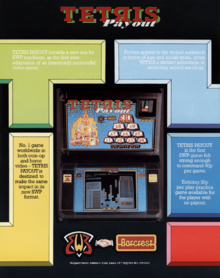| Tetris Payout |
|---|
 Tetris Payout flyer |
| Developer(s) | BWB |
|---|
| Publisher(s) | Barcrest |
|---|
| Platform(s) | Arcade |
|---|
| Release | January? 1990 |
|---|
| Gameplay info |
|---|
| Next pieces | 11 |
|---|
| Playfield size | 10 × 15 (plus 3 rows vanish zone) |
|---|
| Hold piece | No |
|---|
| Hard drop | No |
|---|
|
Tetris Payout is a skill with prize machine published by Barcrest. Reskinned versions of the game were published under the titles Prize Tetris and Blox.
Gameplay
The aim of the game is to score as many points as possible within the time limit (about 2 minutes, further research pending).
The game has two modes:
- "Practise" mode, which allows the player to practice at a reduced cost but without any prizes, and
- "Skill With Prizes" mode, which gives the player a payout for sufficiently high scores.
The playfield is 18 rows high, but locking a piece above row 15 (partial lock out) will result in the game ending. The top out line is not marked.
The game provides 11 previews, however many operators would tape over the preview pane in order to make it harder for players to win consistently.
Scoring
Scoring is based on the height of the cleared row or rows, with higher rows scoring more points up to the tenth row. There appears to be more than one scoring table (further research pending). Rows from the 11th row and above do not score points.
Rotation system
The following diagrams for the JLT piece orientations have their left-most orientation as their initial orientation, and clockwise rotations are applied going to the right.
For the J, L, and T pieces, the piece rotates around its center.
The O piece has a single rotation state.
S, Z, and I are "2-state" with a 3/4-tall initial orientation, but these pieces exhibit a special property:
Counterclockwise rotations from the vertical state will bias the piece to the left, and from the horizontal state will bias the piece to the right.
The opposite is true of clockwise rotations: rotation from the vertical state will bias the piece to the right, and from the horizontal state will bias the piece to the left.
So this S piece:
Could rotate to either of these states:
Same goes for the Z and I pieces.
This Z piece:
Rotates to either:
This I piece:
Rotates to either:
When using only counterclockwise or only clockwise rotations with these pieces, nothing special occurs. However, alternate presses of these rotation buttons will add up the individual biases and cause the piece to drift.
For example:
The I-piece is rotated clockwise, and then counterclockwise. The piece is biased to the right, and then again, which causes the piece to end up one cell to the right of where it was originally.
Notice that the rotation center is always the same in this diagram.
No wallkicks are currently known.
External links


